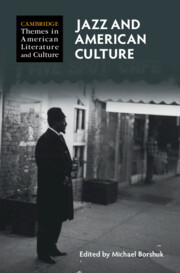Book contents
- Jazz and American Culture
- Cambridge Themes in American Literature and Culture
- Jazz and American Culture
- Copyright page
- Contents
- Contributors
- Acknowledgments
- Introduction
- Part I Elements of Sound and Style
- 1 Improvisation
- 2 Scat and Vocalese
- 3 Jazz as Intertextual Expression
- 4 How to Watch Jazz
- Part II Aesthetic Movements
- Part III Cultural Contexts
- Part IV Literary Genres
- Part V Images and Screens
- Bibliography
- Index
3 - Jazz as Intertextual Expression
from Part I - Elements of Sound and Style
Published online by Cambridge University Press: 09 November 2023
- Jazz and American Culture
- Cambridge Themes in American Literature and Culture
- Jazz and American Culture
- Copyright page
- Contents
- Contributors
- Acknowledgments
- Introduction
- Part I Elements of Sound and Style
- 1 Improvisation
- 2 Scat and Vocalese
- 3 Jazz as Intertextual Expression
- 4 How to Watch Jazz
- Part II Aesthetic Movements
- Part III Cultural Contexts
- Part IV Literary Genres
- Part V Images and Screens
- Bibliography
- Index
Summary
This chapter explores the role of intertextuality in jazz. I argue that major variants of intertextuality– in particular, post-structuralism and Bloom’s “anxiety of influence”– miss what is most important to jazz: the way jazz has served as a vehicle for both the transmission of tradition and a dialogue within it and with other genres. I suggest that Bakhtin’s dialogism illuminates those neglected intertextual features and show how jazz musicians intertextually “re-accent” or “signify” in their use of quotations, licks, style, and repertory. Players quote, use licks, affirm and cross genre boundaries, and improvise over standards in order both to contribute to a tradition and alter it by expressing their individuality. In Jason Moran’s recent work engaging with Thelonious Monk and Fats Waller, he uses stylistic, generic, and repertory-based intertextuality to make the case for jazz as a far reaching but ultimately unified continuum. He thus connects with a larger tradition, but at the same time through recontextualization and re-accenting uses those utterances for self-expression and pushes against cultural– and, by implication, social and political– boundaries. Thus intertextual jazz performances simultaneously express the musicians themselves and engage with the larger whole(s) of which they are a part.
Keywords
- Type
- Chapter
- Information
- Jazz and American Culture , pp. 49 - 63Publisher: Cambridge University PressPrint publication year: 2023

